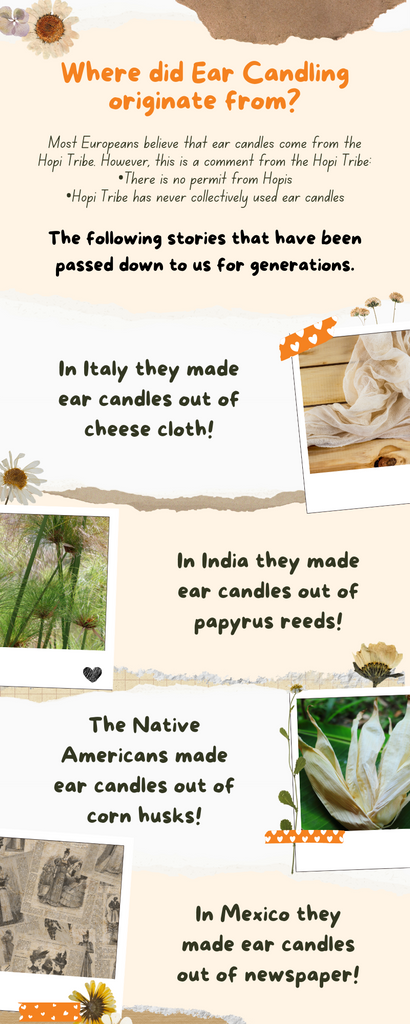Fun Facts About the Ancient Art of Ear Candling
February 27, 2024
Ear candling, often referred to as ear coning, stands as a fascinating and ancient practice with a rich history spanning thousands of years. This time-honored tradition has been embraced by various civilizations, including the Egyptians, Romans, and Greeks, showcasing its positive impact on holistic well-being. As we delve into the depths of ear candling, exploring its roots and therapeutic aspects, we discover a practice that transcends cultures and continues to resonate with individuals seeking a natural and non-invasive approach to well-being.
Ancient Wisdom and Healing Traditions: The roots of ear candling extend deep into ancient civilizations, where it was revered not just as a physical remedy but as a spiritual practice promoting healing on a profound level. The Egyptians, Romans, and Greeks all incorporated ear candling into their holistic wellness practices, emphasizing the interconnectedness of physical and spiritual well-being. The widespread adoption of ear candling across diverse cultures underscores its enduring significance as a therapeutic art.
Hopi Native American Tribe's Spiritual Influence: The origins of ear candling are shrouded in vibrant and legendary narratives that have endured through word of mouth; nevertheless, these stories lack evidence and verification. These myths are recorded by the manufacturers of ear candling products and self-proclaimed authorities in the field, who propagate and distribute this false information to the wider population. The recognized and official Hopi Tribe elders, members, and organization have never granted any authorization or permission for the use of the Hopi name or alleged Hopi techniques by anyone associated with ear candles.
Biosun's Hopi Heritage Controversy: In the controversy surrounding Biosun and the Hopi Tribe, Udo Leshik, Biosun's owner, claimed to learn about ear candling from the Hopi Tribe, particularly Martin Gashweseoma. However, at the time of their 1992 meeting, Gashweseoma was no longer a Hopi Tribe member due to political disputes in 1991. Despite a lack of authorization, Biosun continued to use the Hopi name for their ear candles, prompting the Hopi Cultural Preservation Office to issue guidelines for protecting the tribe's rights and intellectual property. The Hopi Tribe, facing economic challenges, has unsuccessfully sought Biosun's cooperation in stopping the unauthorized use of their name.
Not only has Biosun appropriated the Hopi name for commercial gain, but it has also misrepresented the Grand Canyon in its marketing materials. Featuring a mural from the Desert View Watchtower, Biosun falsely associates ear candling with the Hopi Tribe in the Grand Canyon. This deceptive act underscores the ethical imperative of respecting and obtaining authorization when engaging with the cultural heritage of indigenous communities, exemplified by the Hopi Tribe's ongoing struggle to protect its intellectual property rights.
Untangling the Myths of Ear Candling: A Journey Through Unverified Histories
In the United States, a widespread belief suggests that ear candles have roots in various ancient cultures such as Chinese, Mayan, Egyptian, and even Atlantis. Russell Shepherd, a noted ear candle manufacturer and author, asserts that ear candling, also known as "ear coning," dates back over 3,000 years and was practiced by Egyptians, Essenes, East Indians, Tibetans, and cultures of North and South America and Lemuria. However, these historical claims lack documentation and remain unsubstantiated. Stories of double helix carved cones used in spiritual healing ceremonies by Aztec, Mayan, and Northern Native American shamans, as recounted by Shepherd, are also questioned for their authenticity. Research reveals that some of these narratives stem from channelings held in Sedona, Arizona, particularly a distorted channeling by Eleanor Bucci in 1991. Despite its prevalence, relying on channeling as scientific proof remains controversial, perpetuating inaccurate information within the ear candling community and occasionally infringing upon the traditions of tribal cultures. The persistent myth of ear candling originating from the Hopi Tribe further exemplifies the challenge of separating fact from fiction in the history of this ancient therapy.
Ear Candle Origins Unveiled: Anecdotes Across Cultures and Time
Doc Harmony's research for her dissertation delves into diverse accounts, shedding light on the origins of ear candles:
- Tom Bluewolf, Muscogee Creek Nation (Approx. 70 years old): Used ear candles since age 16, making them from corn husks in his youth.
- Dr. Berryhill, Decatur, GA (Since 1975): Learned about ear candling in 1974 at the Royal Hospital of London from Dr. Christopher, a surgeon, and has been promoting it in the USA since 1975.
- Marie Bando, Beaumont, TX (1953): Cousin, of Lebanese descent, learned to make ear candles from her mother-in-law, treating sickness with ear candling since 1953.
- Jeannie Nastus, Kingston, NJ (1960s): Her mother, hailing from Sicily, Italy, fashioned ear candles using a pencil, handkerchief, and wax. Rosaria Mastus, over 85 years old, continued this tradition upon coming to the USA in the 1960s.
- Leonora Cook, Midvale, UT (Late 1950s): Original owner of Bobalee-Mfg.com, learned about ear candles from Dr. Christopher in the late 1950s.
These accounts reveal a rich tapestry of cultural practices, with individuals from Muscogee Creek Nation, London, Italy, and diverse ancestral backgrounds utilizing various materials for ear candles, emphasizing their use in times of illness.
Harmony Through Ear Candling: An Ancient Practice for Modern Well-being
Ear candling is a therapeutic practice involving a lit, cone-shaped candle placed into the ear. This gentle method creates a warm vacuum, offering a soothing and relaxing experience, promoting calmness, stress reduction, and overall well-being. The global adoption of ear candling fosters cultural appreciation, connecting diverse cultural approaches to holistic health. Positive testimonies and verifiable oral histories from individuals worldwide emphasize the enduring appeal and effectiveness of ear candling. In the modern, fast-paced world, ear candling serves as a sanctuary for relaxation and holistic harmony, aligning with the increasing interest in natural well-being approaches. Verifiable oral testimonies from various cultural backgrounds provide a recent and varied history of ear candling, highlighting its continued relevance in modern holistic practices. In conclusion, ear candling stands as a positive and time-honored practice, transcending cultural boundaries to promote relaxation and balance in a holistic approach to health.

